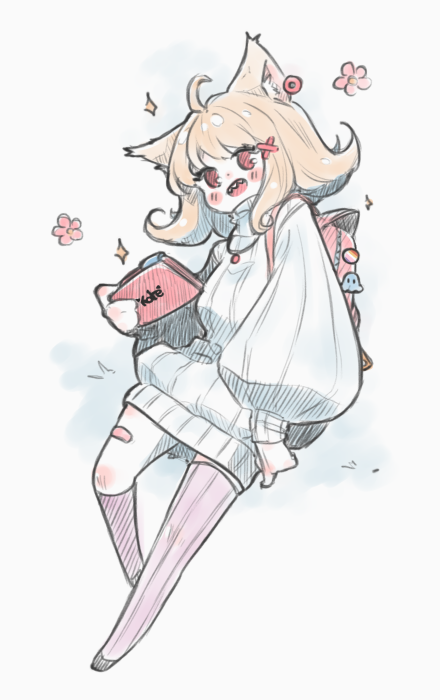Katelog #3: A first preview release!
This was a kind of hectic month in many aspects, but things should be moving at a reasonable pace again. From my side, this marks the release of the remake of my O2A2 game, as well as the release of the very first Kate Preview version.
You can run it from https://kate.qteati.me on any device with a modern browser, or install it from npm and run it from the command line (you want the experimental tag of @qteatime/kate-desktop).
Safer alternatives to local installation will come soon (I’m looking into at least releasing it as sandboxed Snaps on Linux and sandboxed Windows Store appx, a sandboxed MacOS app might also happen in the future). Check the install instructions for current alternative installation modes. Here’s how it looks like once you’re running it:

Besides the example cartridges in the repository, the sound of rain also includes a cartridge download that you can load in the console. Hopefully more coming soon, but there’s still quite a bit that needs to happen in terms of developer documentation before I start trying to get people in this :)
Though, speaking of documentation, I did start writing a user manual and a developer manual, so work’s definitely happening on that front!
Next update should be sometime in May, see you then :>
Katelog #2: Mascots and more
Continuing the weekly-ish updates on my projects, this time we’re talking about… mascots?
As you can imagine I am a big fan of anthropomorphic mascots for computer things, so it’s only fair that I give my own software their own humanoid personifications. Crochet has one, inspired by Forest Girl/Mori fashion and with autumnal colours to give that safe, cozy feeling.

For Kate I wanted something that felt like it could have been there in the 2000s, because the fantasy console is trying to capture that era as well. But I also wanted something that felt cozy and safe, because those are likewise things that Kate as a console aims to be.
The design I ended up on was a girl with cat ears, asymmetric socks, a backpack carried on one shoulder, and very baggy clothing. The palette mimics Kate’s own palette, and the style is loosely inspired by things you’d have seen in the FRUiTS magazine of that era, as well as how me and my friends dressed then, but I tried being a bit less overbearing with the accessories so the silhouette and the associations read a bit better.
Ultimately, both Kate-chan’s aesthetics and the kind of feelings Kate as a console aims to evoke are a product of the 2000s and early 2010s era, so I’m reasonably happy with how she turned out.
Mascots weren’t the only thing happening in Kate the past couple of weeks, though. The two big ones were proper network sandboxing and the redone RPG Maker bridge.
Network sandboxing means that a cartridge can’t make HTTP calls. Having this as a default makes a lot of problems with running cartridges downloaded from random places go away. At worst, malicious cartridges can hog your memory and CPU, and the browser will kill the whole tab. Which is annoying, but not dangerous like having the cartridge steal your online accounts.
The RPG Maker bridge makes it possible to package games built in RPG Maker MV as-is, and have them work locally in Kate without additional effort. The bridge translates regular Web APIs into Kate APIs under the hood, so all resources are loaded from the cartridge binary, and no HTTP calls are made. That’s all the benefits of regular OS executables without their lack of basic security!
Katelog #1: Meet Kate
Imagine if gaming consoles weren’t just for passively consuming things. Imagine if they also encouraged people to make their own games. Build upon others’ works. And even modify the OS and console themselves—to adapt the platform to you, rather than require you to adapt to the platform.
Kate is a fantasy console that I started in 2022 with these goals in mind. It looks like something that could have been out there in the GameBoy Advance or DS era, but with some slightly improved specifications. And a resolution of whole 800 per 480 pixels, to keep that cursed 5:3 aspect ratio alive.

More important than that, however, is that Kate has been made to look cute. It has also been made to allow people to share small story-rich games (think visual novels, interactive fictions, RPGs) that people can fully play offline… without having to worry about it wrecking their computer or doing weird things to your online accounts.
You can read the nitty-gritty details of it on Kate’s Concept Paper, but the short story is that you package a game as a Kate cartridge, send it off to someone so they can install it on their local Kate console, and then Kate takes over with sandboxing the hell out of it to make sure it can’t do any damage—even if the cartridge turns out to be full of malicious code.
Kate is a web-based console—it runs on top of standard web technologies, and it runs games made with standard web technologies, such as HTML and JavaScript. It, however, runs everything offline, so you don’t need internet access to play games. The way it works is a bit involved, but it works.
What Kate is not, currently, is a finished product. Indeed, it’s quite early in its development stages. And even though it can play games, it’s not like there are any games made for it right now. So I’ve been porting my old games to it, and also taking the opportunity to experiment with where I want the platform to go.
I hope I can share more about it here soon. Until then, I’ll leave this small demo of my work-in-progress port of my previous Jam game running in Kate here:
